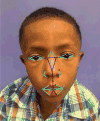22q11.2 deletion syndrome in diverse populations
- PMID: 28328118
- PMCID: PMC5363275
- DOI: 10.1002/ajmg.a.38199
22q11.2 deletion syndrome in diverse populations
Abstract
22q11.2 deletion syndrome (22q11.2 DS) is the most common microdeletion syndrome and is underdiagnosed in diverse populations. This syndrome has a variable phenotype and affects multiple systems, making early recognition imperative. In this study, individuals from diverse populations with 22q11.2 DS were evaluated clinically and by facial analysis technology. Clinical information from 106 individuals and images from 101 were collected from individuals with 22q11.2 DS from 11 countries; average age was 11.7 and 47% were male. Individuals were grouped into categories of African descent (African), Asian, and Latin American. We found that the phenotype of 22q11.2 DS varied across population groups. Only two findings, congenital heart disease and learning problems, were found in greater than 50% of participants. When comparing the clinical features of 22q11.2 DS in each population, the proportion of individuals within each clinical category was statistically different except for learning problems and ear anomalies (P < 0.05). However, when Africans were removed from analysis, six additional clinical features were found to be independent of ethnicity (P ≥ 0.05). Using facial analysis technology, we compared 156 Caucasians, Africans, Asians, and Latin American individuals with 22q11.2 DS with 156 age and gender matched controls and found that sensitivity and specificity were greater than 96% for all populations. In summary, we present the varied findings from global populations with 22q11.2 DS and demonstrate how facial analysis technology can assist clinicians in making accurate 22q11.2 DS diagnoses. This work will assist in earlier detection and in increasing recognition of 22q11.2 DS throughout the world.
Keywords: 22q11.2 Deletion syndrome; DiGeorge syndrome; Velocardiofacial Syndrome; diverse populations; facial analysis technology.
© 2017 Wiley Periodicals, Inc.
Figures






References
-
- Atlas of Human Malformation Syndromes in Diverse Populations. https://www.genome.gov/atlas. Accessed December 27, 2016. - PubMed
-
- Bassett AS, McDonald-McGinn DM, Devriendt K, Digilio MC, Goldenberg P, Habel A, Marino B, Oskarsdottir S, Philip N, Sullivan K, Swillen A, Vorstman J, Consortium International 22q11.2 Deletion Syndrome Practical guidelines for managing patients with 22q11.2 deletion syndrome. J Pediatr. 2011;159:332–9 e1. - PMC - PubMed
-
- Botto LD, May K, Fernhoff PM, Correa A, Coleman K, Rasmussen SA, Merritt RK, O’Leary LA, Wong LY, Elixson EM, Mahle WT, Campbell RM. A population-based study of the 22q11.2 deletion: phenotype, incidence, and contribution to major birth defects in the population. Pediatrics. 2003;112:101–7. - PubMed
-
- Cai D, Zhang C, He X. Unsupervised Feature Selection for Multi-Cluster Data. Proceedings of the 16th ACM SIGKDD international conference on knowledge discovery and data mining. 2010:333–42.
-
- Cerrolaza JJ, Porras AR, Mansoor A, Zhao Q, Summar M, Linguraru MG. Identification of dysmorphic syndromes using landmark-specific local texture descriptors. IEEE Int Symp Biomed Imaging. 2016:1080–83.
MeSH terms
Grants and funding
LinkOut - more resources
Full Text Sources
Other Literature Sources
Medical

